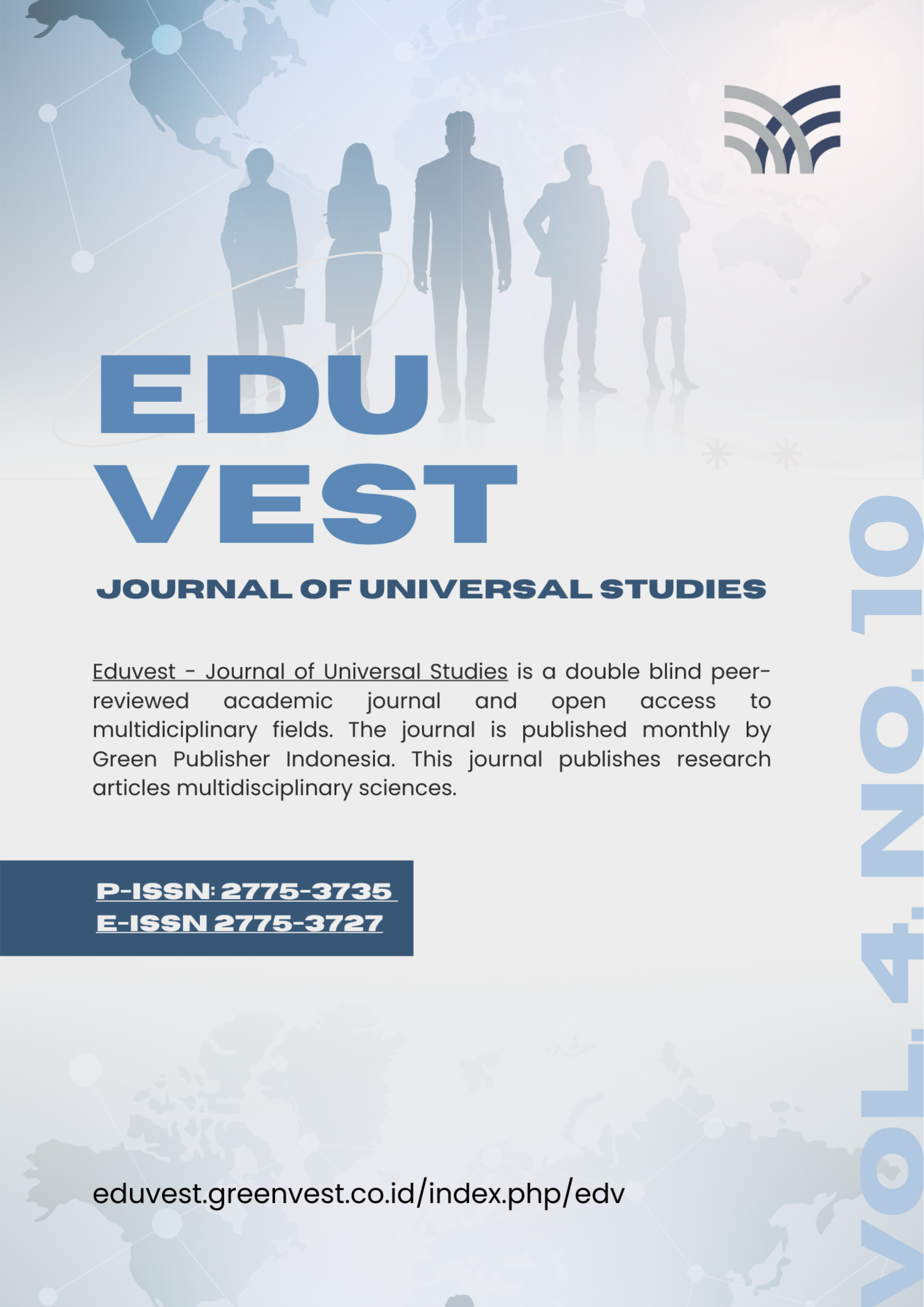The Role of International Normalized Ratio (INR) in Heart Failure Patient With Sepsis: Hidden in Plain Sight
DOI:
https://doi.org/10.59188/eduvest.v4i10.38811Keywords:
Heart Failure, Sepsis, International Normalized Ratio, CoagulopathyAbstract
Heart failure is a clinical syndrome characterized by symptoms and signs caused by a structural and/or functional impairment of the heart. Sepsis in heart failure may cause significant mortality and morbidity rates. Clinically, the presence of heart dysfunction in heart failure worsens outcomes in unstable hemodynamic conditions, for instance, in cases of sepsis, particularly in patients with HFrEF. This research aims to survey the blend of heart failure and sepsis and current updates regarding using the International Normalized Ratio (INR) to detect sepsis. Information was collected from various sources, and updated literature was compiled into a review article. The presence of heart failure with sepsis is associated with horrible clinical results. If fluid alone is insufficient to restore perfusion, the fundamental structure of sepsis includes strong fluid recovery followed by vasopressor association (and possibly inotropic support). In any case, in patients with heart failure, high-portion fluid boluses and vasoactive experts might deteriorate the condition. Heart failure and sepsis can overlap and lead to hemodynamic disturbances and challenging treatment. Meanwhile, aggressive fluid resuscitation is necessary for sepsis; conventional heart failure management requires reducing fluid intake. The International Normalized Ratio (INR) is one of the coagulation parameters that may help determine sepsis in patients with heart failure, thus improving appropriate diagnosis and treatment.
References
Abou Dagher, G., Hajjar, K., Khoury, C., El Hajj, N., Kanso, M., Makki, M., Mailhac, A., & Chebl, R. B. (2018). Outcomes of patients with systolic heart failure presenting with sepsis to the emergency department of a tertiary hospital: a retrospective chart review study from Lebanon. BMJ Open, 8(7), e022185.
Askim, Å., Moser, F., Gustad, L. T., Stene, H., Gundersen, M., Åsvold, B. O., Dale, J., Bjørnsen, L. P., Damås, J. K., & Solligård, E. (2017). Poor performance of quick-SOFA (qSOFA) score in predicting severe sepsis and mortality–a prospective study of patients admitted with infection to the emergency department. Scandinavian Journal of Trauma, Resuscitation and Emergency Medicine, 25, 1–9.
Conrad, N., Judge, A., Tran, J., Mohseni, H., Hedgecott, D., Crespillo, A. P., Allison, M., Hemingway, H., Cleland, J. G., & McMurray, J. J. V. (2018). Temporal trends and patterns in heart failure incidence: a population-based study of 4 million individuals. The Lancet, 391(10120), 572–580.
Czempik, P. F., Herzyk, J., Wilczek, D., & Krzych, Ł. J. (2022). Hematologic System Dysregulation in Critically Ill Septic Patients with Anemia—A Retrospective Cohort Study. International Journal of Environmental Research and Public Health, 19(11), 6626.
Dunlay, S. M., & Roger, V. L. (2014). Understanding the epidemic of heart failure: past, present, and future. Current Heart Failure Reports, 11, 404–415.
Fantz, C. R. (2020). Confirming point-of-care INR test results. Jama, 323(12), 1190–1191.
Jones, T. W., Smith, S. E., Van Tuyl, J. S., & Newsome, A. S. (2021). Sepsis with preexisting heart failure: management of confounding clinical features. Journal of Intensive Care Medicine, 36(9), 989–1012.
McDonagh, T., & Metra, M. (2023). 2021 ESC Guidelines for the diagnosis and treatment of acute and chronic heart failure. Russian Journal of Cardiology, 28(1), 5168.
McGloughlin, S., Richards, G. A., Nor, M. B. M., Prayag, S., Baker, T., & Amin, P. (2018). Sepsis in tropical regions: report from the task force on tropical diseases by the World Federation of Societies of Intensive and Critical Care Medicine. Journal of Critical Care, 46, 115–118.
Nauli, S. E., Putri, V. K. P., Arifianto, H., Prameswari, H. S., Lubis, A. C., Zulkarnain, E., Hasanah, D. Y., Yamin, P. P. D., & Dewi, T. I. (2023). Heart failure with preserved ejection fraction: current status of daily clinical practice in Indonesia. Cureus, 15(4).
Roger, V. L. (2021). Epidemiology of heart failure: a contemporary perspective. Circulation Research, 128(10), 1421–1434.
Roth, G. A., Forouzanfar, M. H., Moran, A. E., Barber, R., Nguyen, G., Feigin, V. L., Naghavi, M., Mensah, G. A., & Murray, C. J. L. (2015). Demographic and epidemiologic drivers of global cardiovascular mortality. New England Journal of Medicine, 372(14), 1333–1341.
Shahim, B., Kapelios, C. J., Savarese, G., & Lund, L. H. (2023). Global public health burden of heart failure: an updated review. Cardiac Failure Review, 9.
Siniarski, A., Gąsecka, A., Borovac, J. A., Papakonstantinou, P. E., Bongiovanni, D., Ehrlinder, H., Giustozzi, M., Guerreiro, R. A., & Parker, W. A. E. (2023). Blood coagulation disorders in heart failure: from basic science to clinical perspectives. Journal of Cardiac Failure, 29(4), 517–526.
Van Nuys, K. E., Xie, Z., Tysinger, B., Hlatky, M. A., & Goldman, D. P. (2018). Innovation in heart failure treatment: life expectancy, disability, and health disparities. JACC: Heart Failure, 6(5), 401–409.
Vincent, J.-L., Jones, G., David, S., Olariu, E., & Cadwell, K. K. (2019). Frequency and mortality of septic shock in Europe and North America: a systematic review and meta-analysis. Critical Care, 23, 1–11.
Williams, J. M., Greenslade, J. H., McKenzie, J. V, Chu, K., Brown, A. F. T., & Lipman, J. (2017). Systemic inflammatory response syndrome, quick sequential organ function assessment, and organ dysfunction: insights from a prospective database of ED patients with infection. Chest, 151(3), 586–596.
Zhang, J., Du, H.-M., Cheng, M.-X., He, F.-M., & Niu, B.-L. (2021). Role of international normalized ratio in nonpulmonary sepsis screening: an observational study. World Journal of Clinical Cases, 9(25), 7405.
Published
How to Cite
Issue
Section
License
Copyright (c) 2024 Pradhika Perdana Sakti

This work is licensed under a Creative Commons Attribution-ShareAlike 4.0 International License.











